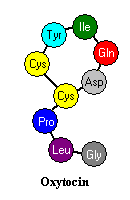Somewhere along the way I read something that lead me to google something that linked me to youtube videos by Bryan Post. Post* bills himself as one of "America's Foremost Child Behavior Experts." While I seriously doubt this is the title I would give him, his work seems to focus on attachment and connections rather than on behavior modification, so I started listening to him. His videos intrigued me because they combine discussions on neurology and attachment - two of my favorite things.
The work horse of his method for being and expert with kids and their behavior is oxytocin, the hormone responsible for bonding sometimes dubbed the "love hormone." Through his videos I learned that the release of oxytocin that creates feelings of warmth and trust is a learned response. Not an automatic physical reaction, but a learned response. If you really think about this, it is a pretty mind-blowing fact. In actuality, we aren't born knowing how to love or being pre-programmed to do so. We have to learn how, from our mommies (or our primary care giver that fills the mothering role). Wow.
I know Holly van Gulden has illustrated this before in reenacting the interactions between baby and mama, showing how the baby feels and expresses mild stress, mama comes in to provide comfort and baby relaxes into her care. But somehow I never got that as parents we are building a neurology of love and connection right into our kids' brains. Good thing the brain is plastic and we can form new neurological pathways at any age - I'm sure many of us humans don't get the positively patterned oxytocin response we need in our first 6 months.
My guess is that part of what makes Neufeld's collecting so successful in the moment and in the long term comes from stimulating the oxytocin response. I've been reading one of Post's sources on the oxytocin response, The Chemistry of Connection by Kuchinskas and the smile and nod of Neufeld's collecting technique come to mind in so many of the oxytocin positive scenarios Kuchinskas sites.
This means, each time I take the needed 3 minutes to get my child's smile and nod, I'm stimulating a dump of warmth, trust, and reward hormones that help my child feel good about themselves and me (oh, and I get a shot of happy hormones, too). Thus they physically are more inclined to do my bidding, and I'm physically more inclined to be nurturing in supporting them. At the same time, I'm creating for them a habit of feeling good, happy and cooperative. The more I do it, the better it gets as the pathways become more refined until the child's oxytocin response becomes automatic, like riding a bike.
Seems like a good idea. Next, I need figure out how to remember in the heat of the moment to aim for those smile and nods and actually figure out how to get them.
*********************************
* Post has obviously read a lot of books on attachment and child development, think pretty clearly about the subject and have quite a bit of experience in the area, so I found much of his information familiar with some exciting new bits. I feel compelled to disclose that in doing a google search for him, I found at least one issue that causes me a little concern about his personal integrity or at least discretion (having to do with challenges to his title of "dr"). It didn't discredit his thinking for me, but if you plan to put much energy into looking at his videos or programs, you might consider looking into this for yourself.

No comments:
Post a Comment